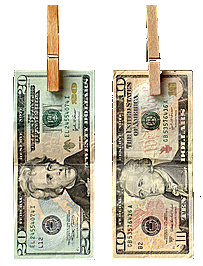Tax planning over the long-term should not just focus on your projected income in relation to expenses. Rather, the timing for the payment of those expenses in itself can easily yield thousands of dollars in tax savings. In addition, unless a taxpayer anticipates a large change in their income due to an investment or a home sale or retirement, chances are that your income will not be fluctuating that much from year to year. So, what is this lesser-known tax planning technique?
 The standard deduction versus itemizing expenses
The standard deduction versus itemizing expenses
A classic question that always arises is whether or not to itemize or use the standard deduction. The general guidance is to claim the one that provides the greatest tax benefit. In many cases, the taxpayer will need to compare the standard deduction with their actual itemized expenses. For 2014, the standard deduction for married couples filing a joint return is $12,400 and $6,200 for single individuals and married couples filing separately. For those filing head of household, the standard deduction is $9,100. In comparison, by itemizing deductions, taxpayers are electing to claim the their actual mortgage interest, charitable deductions, state and local taxes and other expenses.
Tax deduction planning
While the tax benefit comparison of electing the standard deduction versus itemizing can be a useful exercise in maximizing tax savings in a given year, the benefit can be greater if utilized over a period of two years. Specifically, the taxpayer may be able to boost overall deductions for every two-year period by alternating between the standard deduction and itemizing each year. This would mean making your charitable donations and state and local tax payments in the year you itemize for the current year and pre-paying for the following year. This would effectively double your itemized deductions for the year.
Here’s the scenario. You’re married and filing jointly with eligible itemized deductible expenses of $15,000 in state income taxes, property taxes, mortgage interest and qualified charitable donations. The potential itemized deductions for the year are only marginally greater than the $12,400 standard deduction allowed for joint filers. However, if the taxpayer claims two years’ worth of charitable donations in a single year and prepays next year’s state and local taxes by December 31, that $15,000 could increase to $20,000 plus. Suddenly, the taxpayer can deduct far more than the standard option by itemizing. In the following year, they will not be able to claim the same charitable donations and state and local taxes paid in the prior year, but they can claim the standard deduction instead. The amount available to itemize would ideally be much less than the $12,400 standard deduction. The tax savings by utilizing this approach could be in the thousands.
Are there any drawbacks to utilizing this strategy?
Yes, it’s possible that the taxpayer has less financial flexibility as a result of prepaying these expenses. In addition, they would lose out on the interest earned on those monies. Having said that, interest rates are still low, so the loss would be minimal.
Taxpayers may also find solace in claiming the standard deduction each year as it’s less paperwork in preparing their tax return each year.
In addition, certain states don’t allow taxpayers to deduct prepaid state and local taxes. This could be a deal breaker in utilizing this strategy.
More questions? Browse answers or ask tax questions online.
Related Articles
->Are You Overlooking These 2013 Tax Deductions?
->What Documentation Do I Need To Deduct Charitable Donations?
->How Much Can You Expect To Pay Your Accountant This Year?
->What Are The Tax Breaks For Purchasing A Home


